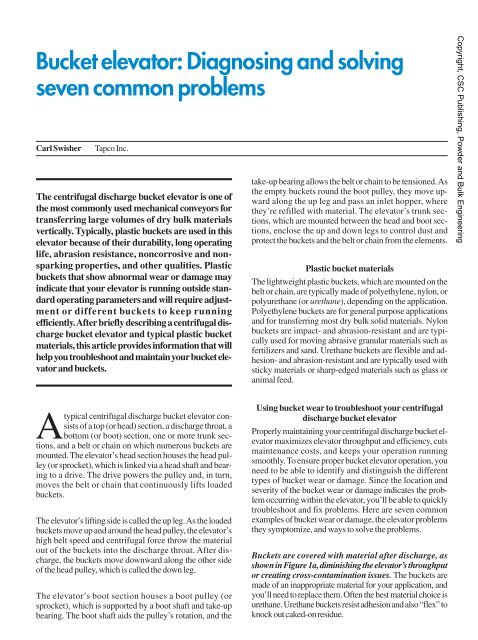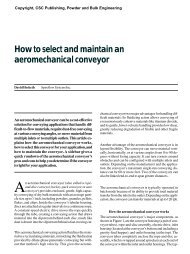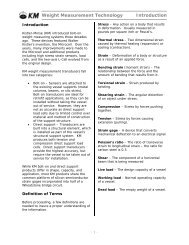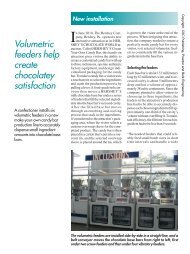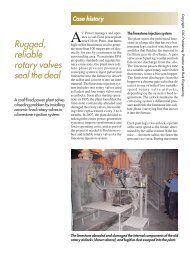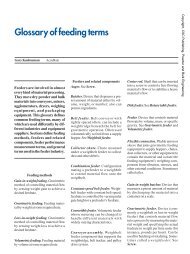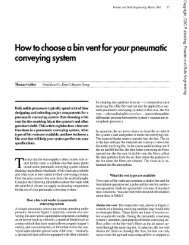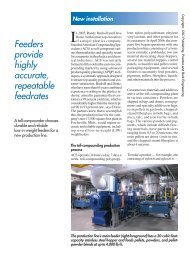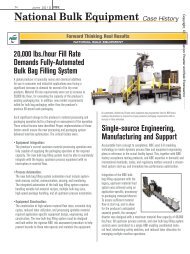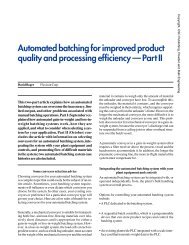Bucket elevator: Diagnosing and solving seven common problems
Bucket elevator: Diagnosing and solving seven common problems
Bucket elevator: Diagnosing and solving seven common problems
You also want an ePaper? Increase the reach of your titles
YUMPU automatically turns print PDFs into web optimized ePapers that Google loves.
<strong>Bucket</strong> <strong>elevator</strong>: <strong>Diagnosing</strong> <strong>and</strong> <strong>solving</strong><br />
<strong>seven</strong> <strong>common</strong> <strong>problems</strong><br />
Carl Swisher<br />
Tapco Inc.<br />
The centrifugal discharge bucket <strong>elevator</strong> is one of<br />
the most <strong>common</strong>ly used mechanical conveyors for<br />
transferring large volumes of dry bulk materials<br />
vertically. Typically, plastic buckets are used in this<br />
<strong>elevator</strong> because of their durability, long operating<br />
life, abrasion resistance, noncorrosive <strong>and</strong> nonsparking<br />
properties, <strong>and</strong> other qualities. Plastic<br />
buckets that show abnormal wear or damage may<br />
indicate that your <strong>elevator</strong> is running outside st<strong>and</strong>ard<br />
operating parameters <strong>and</strong> will require adjustment<br />
or different buckets to keep running<br />
efficiently. After briefly describing a centrifugal discharge<br />
bucket <strong>elevator</strong> <strong>and</strong> typical plastic bucket<br />
materials, this article provides information that will<br />
help you troubleshoot <strong>and</strong> maintain your bucket <strong>elevator</strong><br />
<strong>and</strong> buckets.<br />
take-up bearing allows the belt or chain to be tensioned. As<br />
the empty buckets round the boot pulley, they move upward<br />
along the up leg <strong>and</strong> pass an inlet hopper, where<br />
they’re refilled with material. The <strong>elevator</strong>’s trunk sections,<br />
which are mounted between the head <strong>and</strong> boot sections,<br />
enclose the up <strong>and</strong> down legs to control dust <strong>and</strong><br />
protect the buckets <strong>and</strong> the belt or chain from the elements.<br />
Plastic bucket materials<br />
The lightweight plastic buckets, which are mounted on the<br />
belt or chain, are typically made of polyethylene, nylon, or<br />
polyurethane (or urethane), depending on the application.<br />
Polyethylene buckets are for general purpose applications<br />
<strong>and</strong> for transferring most dry bulk solid materials. Nylon<br />
buckets are impact- <strong>and</strong> abrasion-resistant <strong>and</strong> are typically<br />
used for moving abrasive granular materials such as<br />
fertilizers <strong>and</strong> s<strong>and</strong>. Urethane buckets are flexible <strong>and</strong> adhesion-<br />
<strong>and</strong> abrasion-resistant <strong>and</strong> are typically used with<br />
sticky materials or sharp-edged materials such as glass or<br />
animal feed.<br />
Copyright, CSC Publishing, Powder <strong>and</strong> Bulk Engineering<br />
Atypical centrifugal discharge bucket <strong>elevator</strong> consists<br />
of a top (or head) section, a discharge throat, a<br />
bottom (or boot) section, one or more trunk sections,<br />
<strong>and</strong> a belt or chain on which numerous buckets are<br />
mounted. The <strong>elevator</strong>’s head section houses the head pulley<br />
(or sprocket), which is linked via a head shaft <strong>and</strong> bearing<br />
to a drive. The drive powers the pulley <strong>and</strong>, in turn,<br />
moves the belt or chain that continuously lifts loaded<br />
buckets.<br />
The <strong>elevator</strong>’s lifting side is called the up leg. As the loaded<br />
buckets move up <strong>and</strong> around the head pulley, the <strong>elevator</strong>’s<br />
high belt speed <strong>and</strong> centrifugal force throw the material<br />
out of the buckets into the discharge throat. After discharge,<br />
the buckets move downward along the other side<br />
of the head pulley, which is called the down leg.<br />
The <strong>elevator</strong>’s boot section houses a boot pulley (or<br />
sprocket), which is supported by a boot shaft <strong>and</strong> take-up<br />
bearing. The boot shaft aids the pulley’s rotation, <strong>and</strong> the<br />
Using bucket wear to troubleshoot your centrifugal<br />
discharge bucket <strong>elevator</strong><br />
Properly maintaining your centrifugal discharge bucket <strong>elevator</strong><br />
maximizes <strong>elevator</strong> throughput <strong>and</strong> efficiency, cuts<br />
maintenance costs, <strong>and</strong> keeps your operation running<br />
smoothly. To ensure proper bucket <strong>elevator</strong> operation, you<br />
need to be able to identify <strong>and</strong> distinguish the different<br />
types of bucket wear or damage. Since the location <strong>and</strong><br />
severity of the bucket wear or damage indicates the problem<br />
occurring within the <strong>elevator</strong>, you’ll be able to quickly<br />
troubleshoot <strong>and</strong> fix <strong>problems</strong>. Here are <strong>seven</strong> <strong>common</strong><br />
examples of bucket wear or damage, the <strong>elevator</strong> <strong>problems</strong><br />
they symptomize, <strong>and</strong> ways to solve the <strong>problems</strong>.<br />
<strong>Bucket</strong>s are covered with material after discharge, as<br />
shown in Figure 1a, diminishing the <strong>elevator</strong>’s throughput<br />
or creating cross-contamination issues. The buckets are<br />
made of an inappropriate material for your application, <strong>and</strong><br />
you’ll need to replace them. Often the best material choice is<br />
urethane. Urethane buckets resist adhesion <strong>and</strong> also “flex” to<br />
knock out caked-on residue.
<strong>Bucket</strong>s are weakened or degraded, as shown in Figure 1b.<br />
This suggests that the buckets can’t withst<strong>and</strong> an extremely<br />
hot material from an upstream process. To solve this problem,<br />
cool the material before conveying it to the bucket <strong>elevator</strong>,<br />
or install plastic buckets that can h<strong>and</strong>le the material’s<br />
hot temperature. The average operating temperature range<br />
for polyethylene buckets is -60°F to 200°F (-51°C to 93°C).<br />
The typical temperature range for nylon buckets is -40°F to<br />
275°F (-40°C to 135°C). And the range for urethane buckets<br />
is around -60°F to 212°F (-51°C to 100°C).<br />
<strong>Bucket</strong>s’ front lips are worn <strong>and</strong> have sharp edges, as<br />
shown in Figure 1c.This implies that the <strong>elevator</strong>’s belt or<br />
chain is improperly tensioned. You’ll need to increase the<br />
belt or chain tension to prevent the buckets from sliding<br />
along the bottom of the boot.<br />
<strong>Bucket</strong>s’ sides are worn or scored, as shown in Figure 1d.<br />
This shows that the <strong>elevator</strong>’s belt or chain isn’t tracking<br />
properly. To fix this, adjust the belt tracking across the<br />
head pulley’s crown by increasing the belt or chain tension<br />
to prevent the bucket from scraping along the leg casing.<br />
Figure 1<br />
Examples of bucket wear or damage<br />
a. Material stuck to the<br />
b. Degraded bucket<br />
bucket surface<br />
c. Worn front bucket lip<br />
with sharp edges<br />
d. Worn bucket sides<br />
Copyright, CSC Publishing, Powder <strong>and</strong> Bulk Engineering<br />
<strong>Bucket</strong>s’ interior surface is worn, exhibiting a s<strong>and</strong>blast<br />
effect, as shown in Figure 1e. This means that the material’s<br />
feed velocity into the bucket is too high. To prevent<br />
this, you’ll need to reduce the material’s infeed velocity,<br />
install baffles at the leg entrance, or replace the existing<br />
buckets with more abrasion-resistant urethane buckets.<br />
<strong>Bucket</strong>s’ front lips are stretched out or broken, as shown<br />
in Figure 1f, or the bolts that secure the buckets to the<br />
belt or chain are broken. This suggests that there are obstructions<br />
inside the <strong>elevator</strong> or that the <strong>elevator</strong>’s belt or<br />
chain is improperly tensioned. First, check the <strong>elevator</strong>’s<br />
boot <strong>and</strong> throat-plate clearances <strong>and</strong> each leg casing for any<br />
obstructions that the buckets may be impacting, such as an<br />
open inspection door or tramp metal. Next, increase the belt<br />
or chain tension to keep it taut so that it doesn’t flap <strong>and</strong> allow<br />
the buckets to hit the <strong>elevator</strong>’s interior or internal components.<br />
If necessary, install impact-resistant nylon buckets.<br />
Material doesn’t completely fill into the buckets or discharges<br />
from them too late or too early (called backlegging)<br />
or not at all. This indicates that the buckets are filling<br />
or discharging inefficiently, which diminishes the <strong>elevator</strong>’s<br />
throughput capacity. A solution is to install vented<br />
buckets to improve the efficiency of bucket fill or discharge.<br />
Figure 2 shows an example of a vented bucket.<br />
These buckets are available with various numbers of vents<br />
in various configurations, depending on the application.<br />
For dense materials such as flour, meals, or mash feeds, the<br />
bucket vents allow air to escape as the bucket is filled. During<br />
discharge, the vents allow air to return into the bucket,<br />
preventing a vacuum from forming that can hold material<br />
in the bucket <strong>and</strong> cause backlegging. For extremely light<br />
materials such as alfalfa or bran, the bucket vents decrease<br />
e. Worn bucket interior f. Stretched-out front bucket lip<br />
Figure 2<br />
Example of a vented bucket
the air turbulence that can occur in the <strong>elevator</strong> up leg. Reducing<br />
the air currents minimizes the circulatory pressure<br />
within the <strong>elevator</strong>, which can draw a light material<br />
through the down leg <strong>and</strong> back to the boot. Your <strong>elevator</strong><br />
manufacturer or bucket supplier can help determine the<br />
vent pattern best suited for your application.<br />
Maintaining your bucket <strong>elevator</strong><br />
To properly maintain your centrifugal discharge bucket <strong>elevator</strong>,<br />
establish <strong>and</strong> follow a preventive maintenance program<br />
that includes regularly scheduled inspections of the<br />
<strong>elevator</strong> <strong>and</strong> buckets. Visually inspect these at least once a<br />
month, if not more, depending on how often you use the <strong>elevator</strong>.<br />
Use the following checklist when inspecting your<br />
<strong>elevator</strong> <strong>and</strong> buckets:<br />
• Check for broken, bent, or missing buckets <strong>and</strong> replace<br />
them.<br />
• Retighten or replace the bolts <strong>and</strong> nuts that hold the buckets<br />
to the belt or chain.<br />
• Verify proper alignment, tension, <strong>and</strong> physical condition<br />
of the belt or chain; check for wear, stretching, or delamination.<br />
• Check the throat plate <strong>and</strong> adjust if necessary.<br />
• Look for wear on the head <strong>and</strong> boot pulleys.<br />
• Clean inside the boot area <strong>and</strong> around the <strong>elevator</strong> <strong>and</strong><br />
drive equipment.<br />
• Inspect <strong>and</strong> lubricate all bearings <strong>and</strong> moving parts in the<br />
<strong>elevator</strong>.<br />
Copyright, CSC Publishing, Powder <strong>and</strong> Bulk Engineering<br />
For additional guidance, contact your <strong>elevator</strong> manufacturer<br />
or bucket supplier.<br />
PBE<br />
For further reading<br />
Find more information on this topic in articles listed under<br />
“Mechanical conveying” in Powder <strong>and</strong> Bulk Engineering’s<br />
comprehensive article index (in the December 2010<br />
issue <strong>and</strong> at PBE’s Web site, www.powderbulk.com) <strong>and</strong><br />
in books available on the Web site in the PBE Bookstore.<br />
You can also purchase copies of past PBE articles at<br />
www.powderbulk.com.<br />
Carl Swisher is sales manager for domestic <strong>and</strong> international<br />
sales at Tapco Inc., 225 Rock Industrial Park Drive,<br />
St. Louis, MO 63044; 314-739-9191, ext. 1920, fax 314-<br />
739-5880 (carls@tapcoinc.com, www.tapcoinc.com). He<br />
holds a BA from Washington University in St. Louis <strong>and</strong> an<br />
MBA from The Stern School of New York University in New<br />
York <strong>and</strong> has more than 20 years of experience in industrial<br />
sales <strong>and</strong> international business.


